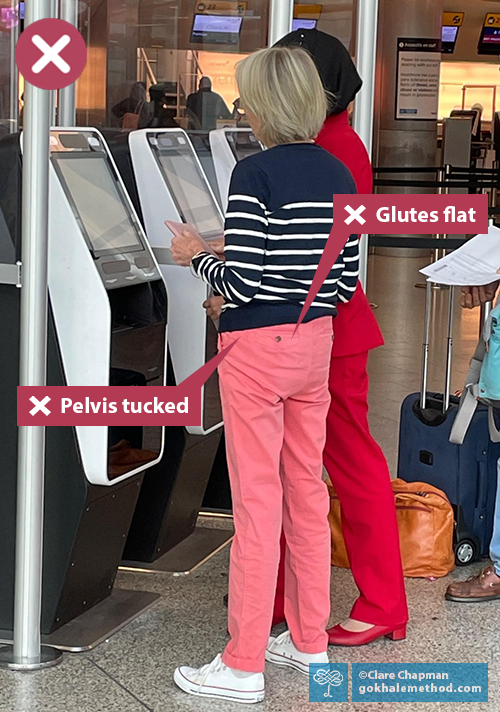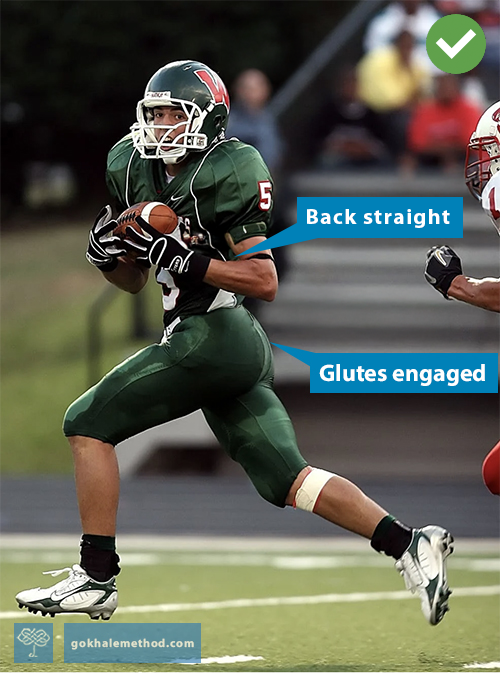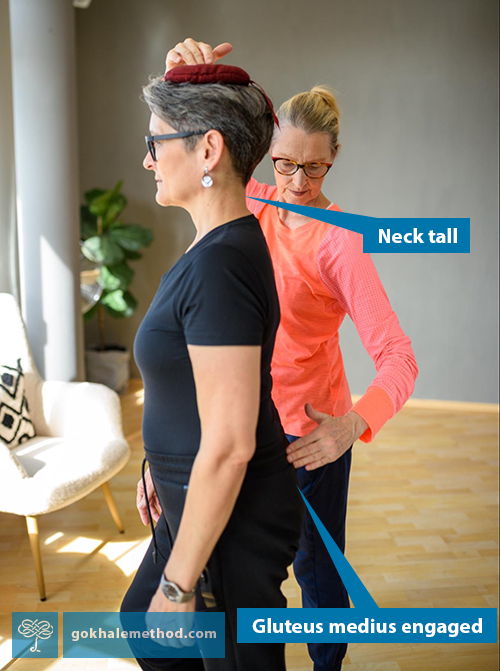Why Healthy Glutes Reduce Aches and Pains
Over the decades that our students have gotten out of pain by learning the Gokhale Method®, it has become clear that healthy glutes are essential in this. Well-functioning glutes hold the key to unlocking many poor postural habits, and contribute to better biomechanics and movement. Good glute function will often solve pain and enable healing in apparently unconnected areas of the body. Let’s take a look at some of the common, and sometimes surprising, aches and pains that respond to our glute training…
If you tire easily in walking
The gluteus maximus is designed to be the largest muscle in the body. You want these muscles to be well developed, rounded, and pert, rather than weak, flat, and droopy. You also want your glutes positioned behind you—that’s why it’s called your behind!—rather than underneath you because you tuck your pelvis.

Tucking the pelvis under the torso makes for weak, flat glutes.

The glutes power us from behind.
In a posterior position your glutes work to pull your thigh bones back, like little jets that efficiently propel you forward. And healthy glutes look good, too!
Do you have poor balance or a waddling gait?
With advancing years people sometimes experience new difficulty maintaining an easy balance in walking. Or they may be told that they have started to waddle from side to side—not ideal. The likely culprit here is a weakness in the gluteus medius muscle, located in the upper, outer quadrant of the buttocks. It plays an important role in balance as it controls the relative positions of the pelvis and leg. This muscle gets a lot of attention in our offerings—the in-person Gokhale Foundations course, one-day Gokhale Immersion Pop-up course, our online Gokhale Elements course, plus our Gokhale Active program.
Lower back pain
If the gluteal muscles are not powering your stride from behind, you will be overly reliant on the psoas, quads, and other anterior chain muscles pulling you forward. An overly tight, shortened psoas can cause a lot of trouble, including pulling on the lumbar vertebrae, causing a sway back with compression of the area’s discs, nerves, soft tissues, and bones. A stiff lower back in the morning can be a sign of a tight psoas muscle.

A tight and shortened psoas muscle can pull on the vertebrae, causing a swayed back and compression in the lumbar spine.
Can my glutes really affect my knee and hip?
It’s said that everything’s connected, and that’s true here…Weak glutes give rise to a tight psoas that can restrict and compact the hip because the psoas runs from above to below that joint—this span makes it a key hip flexor. Other anterior chain tissues, including the quadriceps muscle and iliotibial band, may also become chronically tight if they are compensating for weak glutes. This can cause compression, wear and tear, or inflammation at various points between the hip and lower knee.
What about SI joint and pelvic instability?
While there are many factors involved in lower back pain and the instability and spasms that can affect this area, the vast majority of students who come to us suffering in this way see improvements. The pelvis and spine are stabilized by the inner corset and the glutes, as they learn to work in harmony.
Sciatic pain from piriformis syndrome
Your piriformis muscles lie deep under the buttocks running from the sacrum to the hips. If the glutes are weak, the piriformis will try to step up to do their job—often resulting in chronic contraction. In this state, the piriformis can press on the sciatic nerve, which passes alongside or, in some people, through it. A “knotty” piriformis is that sore spot that a massage therapist may dig into with their elbow to release—but the lasting solution is to recondition the glutes.

Weak glutes can cause deeper muscles alongside the sciatic nerve to become hypertonic and impinge on the nerve. Image from Thinkstock
Power up your glutes, be kind to your feet
A weak and poorly well-coordinated glute pack is unlikely to be able to maintain the pelvis and legs in the right position, and so walking becomes a series of thuds on the ground. Harsh landings may well result in jarring and damage all the way through to the neck; but your feet are first in line and most prone to suffer, with issues like plantar fasciitis, heel spurs, and tendonitis.
Introduce your glutes to glidewalking
To remedy, or even better, prevent these problems, we love to introduce our students to glorious glutes and the pleasures of glidewalking. Glidewalking describes the strong but smooth natural gait pattern which emerges as the glutes learn to contract and release powerfully and rhythmically.

Students find their glutes respond well to hands-on cues—both from a teacher, and from what they can learn to do for themselves.
Join us for our special Spring into Action free online workshops for newcomers
We encourage newcomers to enjoy Esther’s special, free, Put a Spring in Your Step: Glidewalk your Way to Healthy, Pain-Free Movement Gokhale Method beginner workshop, this Saturday, April 26, 11:00 a.m.–12:00 p.m. (PST). Esther will be teaching glidewalking techniques you can start practicing straight away. The workshop will also launch a special, free 5-Day Glidewalking challenge to help you develop your walking power! Find out more, and sign up here.
Best next action steps
If you would like help boosting your glutes through healthy posture, get started by booking a Gokhale Consultation, online or in person, with one of our teachers.
You can sign up below to join any one of our upcoming FREE Online Workshops…

Comments
Add New Comment
Login to add commment
Login